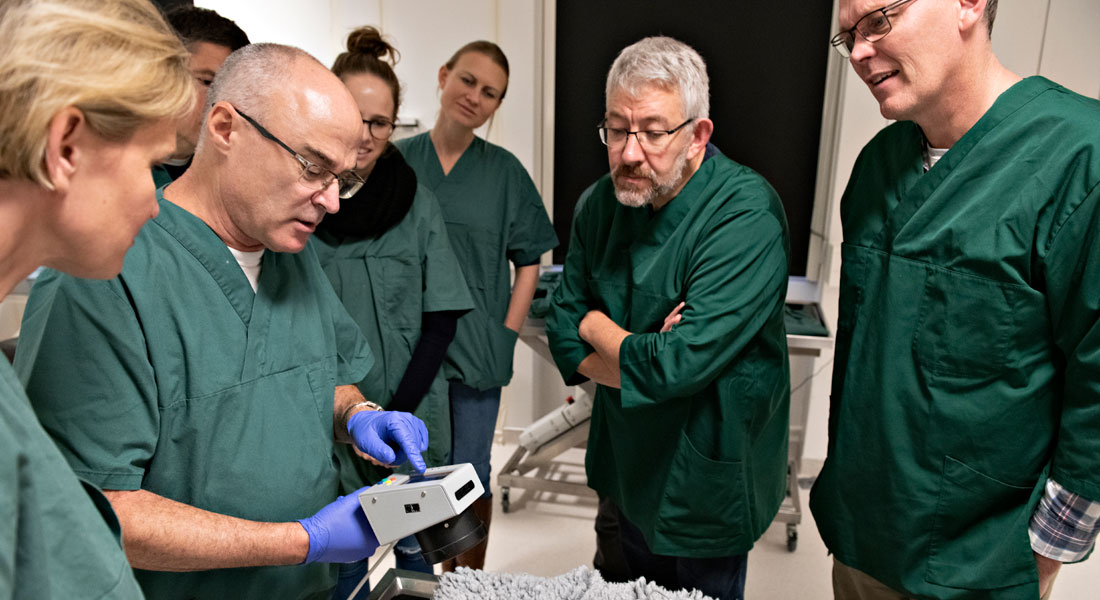Companion Animal Ophthalmology – Basic Companion Animal Ophthalmology
This course is a specialisation course at the Master of Companion Animal Clinical Science. The Master is a post graduate education targeted small animal veterinarians seeking Continuing Professional Development (CPD).

The purpose of this course is:
- To provide the student with theoretical and practical skills to understand the underlying causes for ocular diseases, and to perform diagnostic work-up, establish prognosis and develop therapeutic strategies for the management of:
- dogs and cats with congenital ocular diseases.
- dogs and cats with hereditary ocular diseases.
- dogs and cats with ocular manifestation of systemic diseases.
- dogs and cats with neoplastic ocular diseases.
- To provide the student with hands on knowledge in how to use a handheld slit-lamp for biomicroscopy examination.
- To provide the student with hands on knowledge in the field of direct and indirect ophthalmoscopy.
- To provide the student with hands on knowledge in the field of advanced diagnostic testing for ophthalmic diseases; including cytology, pathology, and electroretinography. To demonstrate the use of advanced CT and MRI in veterinary ophthalmology.
- By theory and practical exercises to extend the student’s knowledge, practical skills and competences within the clinical decision making and diagnostic procedures with regards to companion animal ophthalmic diseases.
Read more about the Master of Companion Animal Clinical Science.
A mixture of lectures, e-learning, theoretical and practical exercises. Case-study work.
Having completed the course, the student must be able to:
Knowledge
- Explain, reflect about and demonstrate overview of the systematic approach to the patient with congenital ocular diseases.
- Explain, reflect about and demonstrate overview of the systematic approach to the patient with symptoms of hereditary ocular diseases.
- Explain, reflect about and demonstrate overview of the systematic approach to the patient with symptoms of ocular manifestation of systemic diseases.
- Explain, reflect about and demonstrate overview of the systematic approach to the patient with symptoms of neoplastic ocular diseases.
- Know ocular pharmacological drugs that can be used in veterinary ophthalmology.
- Know aetiology, diagnosis, treatment and prognosis for ocular diseases in dogs and cats at an advanced level
- To define, identify and evaluate veterinary methodology and the use of general and advanced veterinary diagnostic methods for veterinary ophthalmology patients.
Skills
- Apply evidence based approaches to dogs and cats with complex ophthalmic symptoms.
- Perform oral presentation of patient history, symptoms and diagnostic plan for both specialist and non-specialist colleagues and clients.
- Discuss relevant problems and questions within the systematic approach to patients with complex ophthalmic symptoms.
- Use and adjust slit lamp biomicroscopy.
- Use and adjust headset for indicted ophthalmoscopy.
- Perform gonioscopy examination at a basic level.
- Perform an electroretinogram (ERG) at a basic level.
- Perform ocular ultrasonographic examination at a basic level.
- Interpret, assess, and reflect on collected patient data in order to identify/localize the cause of ocular disease occurrence, make clinical decisions, arrive at a diagnosis and apply and integrate evidence based scientific approaches to plan and administer further diagnostics, patient therapy and management.
Competences
- Collaborate and communicate within and between specialist and non-specialist peers and lay persons involved in companion animal patient management.
- Plan, evaluate and manage a diagnostic work-up and treatment of patients with complex ocular diseases.
- Independently obtain, evaluate and elaborate on evidence based new knowledge at a specialty level within complex ocular diseases.
You must meet the following criteria to be admitted to this course:
- Hold a degree in Veterinary Medicine.
- Hold one of the following certifications:
- DVA Certificate in Small Animal Diseases (equivalent to the 4 compulsory courses of the Master of Companion Animal Clinical Science).
- Swedish / Norwegian / Finnish specialist in diseases of dogs and cats.
- Equivalent competences.
- Have a minimum of 2 years of relevant work experience from companion animal practice.
- Be proficient in English.
Find detailed information about the formal requirements for this course.
The course responsible at the specialisation track in Companion Animal Cardiology is:
- Professor of Companion Animal Clinical Oncology Annemarie Thuri Kristensen, University of Copenhagen.
Lecturers at the specialisation track are:
- Assistant Professor of Veterinary Ophthalmology Michala de Linde Henriksen, Colorado State University (CSU).
- National and international capacities within the field.
Course details
| Duration: | 5 days |
| Dates: | Offered next time fall 2025 |
| Frequency: | Only available every second year |
| Course capacity: | 12 students |
| Place: | University Hospital for Companion Animals, Frederiksberg, Denmark |
| Course fee: | EU/EEA citizens Single course participant: 36,500 DKK Master student: 33,000 DKK Non-EU/EEA citizens Single course participant: 40,740 DKK Master student: 37,240 DKK Tuition fees include course materials and lunch/coffee. Books are not included in the tuition fees and must be purchased by the participants. |
| Level and credit: | Master course; 6 ECTS |
| Examination date: | Please consult the exam schedule |
| Application deadline: | Master's programme: 1 May 2025 Course: September 2025 |
| Admission: | To be admitted, you must meet the admission criteria for specialisations at Master of Companion Animal Clinical Science |
The opening of the application period is announced via the programme newsletter.
Download course curriculum
